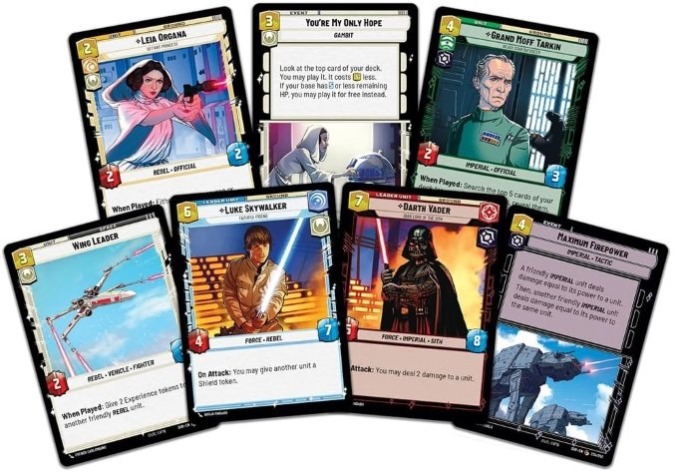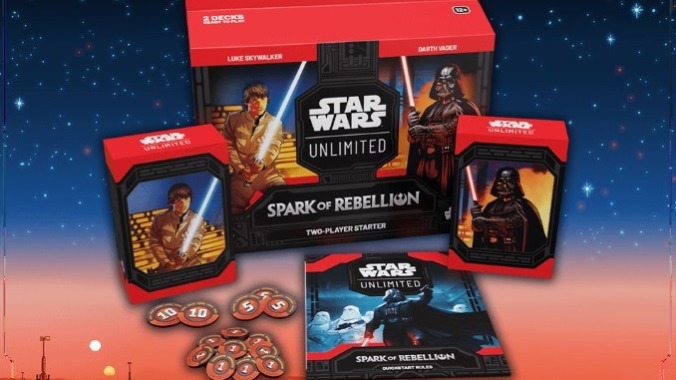Star Wars: Unlimited—Spark of Rebellion is just the latest effort to take the Magic: the Gathering formula to another thematic universe, following the wildly successful 2023 release Disney Lorcana from Ravensburger. And since the expanded Star Wars universe provides a tremendous amount of content for the public’s inevitable thirst for more packs, there’s already huge interest in the game and a thriving secondary market. It’s not my type of game experience, but I can see why this one has caught on so quickly.
I’ve never been a deckbuilder guy, particularly not of the sort known as collectible card games, or CCGs, although various companies have given their own names to the genre. These games incorporate two things I don’t generally like in games: the need to continue buying or acquiring game components to keep up with the competition, and the need to do advance preparation before playing by building and honing your deck. (In that way, it reminds me of playing fantasy baseball, a hobby that took up a huge amount of my time from the year I graduated high school until baseball became my full-time job 13 years later.) These attributes are also a big part of the genre’s success—people love the collecting, love the hunt for new or rare cards, love playing around with their decks to try to find the ideal card combinations.
The two starter packs each contain a Leader—Luke Skywalker or Darth Vader—as well as a base card, a deck of 50 cards to be drawn and played over the course of the game, and three shield/experience upgrade cards. The goal is to destroy your opponent’s base, each of which has 30 hit points in the starter packs, before they destroy yours. Your Leader starts the game in play as a static card that can’t attack or be attacked, with some modest power it can use as an action each turn, but once you meet a specific criterion you can then put it into play, where it becomes quite powerful—but where your opponent can also defeat it and send it back to its weaker, static mode for the remainder of the game.
The game play itself is pretty simple to learn, although the terms and icons are less so and make the cards a bit cluttered. Each player starts the game by shuffling their deck and drawing six cards, then placing two of them face-down as ‘resources,’ which determine the number and strength of actions they may take each turn. The player cedes the right to use the powers or actions on any card played as a resource, so it’s a significant choice for the start of the game. Each player may choose once to discard their initial six-card draw and start over, but they’re stuck with the second sextet.

Players randomly determine who has initiative, which marks the start player for each round, and then they take turns playing cards to the table or using actions on cards that they’ve already played. Each card has a resource cost in the upper left, and to play it you ‘exhaust’ that many cards from your resource section by turning them 90 degrees to show they’ve been used for that round—a very common mechanic in CCGs and in many tabletop games as well. You will start the game with two resources, so setting up your initial hand with at least one card of cost 1 or 2 is key so you get a fighting unit on the table. Cards enter play exhausted, so you can use their action in the subsequent turn, with a few exceptions. Actions usually don’t require resources, including attacking, so you keep building up resources to get more cards to the table—and replace the ones you’ve lost in the war. There are also event cards, which you play like resources but which are discarded after a single use.
Attacking is also simple, and highly efficient in a brutal way. Each unit card either goes to the space side or the ground side of the table, and can only attack units on the same side. Each card has an attack power and a health/hit points total. When you attack, you pick an opposing unit or their base, and then deal damage equal to your attacking unit’s power. Other units fight back equal to their power, so you can take more damage than you deal and often lose your unit in the process. Bases don’t fight back, at least, although you may need to take out a particularly irksome enemy card instead.
The difficulty is in the details, as there are a lot of cards that tweak or change the rules I described above. Many cards have effects on other cards of certain types (e.g., just vehicles) or that have certain icons, which do have unique colors but with hard-to-distinguish symbols. Ambush cards come into play ready. Sentinel cards must be attacked before any other units in their area or before the base. A shielded card doesn’t take damage when attacked, losing its shield instead. Overwhelm powers mean excess damage goes to the base once the target unit is dead. And so on. You can play the basic game pretty easily by just rolling with these terms as they come along, but strategizing, including making card choices, requires knowing the ins and outs more than you will your first or second play.
There are already over 200 cards in circulation, including 18 different leaders and 12 bases, with the expected scarcity already in the market as the game has proved extremely popular, and Fantasy Flight has already marketed a number of fancy upgrades like card holders (which, I admit, are pretty slick if you’ve decided this is the game for you). It offers a lower barrier to entry than many other CCGs I’ve seen or played, including Magic itself, and I think the theme will help draw some younger players into it—not to mention the collectible aspect, which I think drove the Pokemon card craze more than the game itself. (I’m arguing from personal experience here—I know at least three kids under 10 who collect the cards and, when I asked, had no idea how to play the actual game.) The only other CCG I’ve played that I liked as much as this one was the Game of Thrones Living Card Game, also from Fantasy Flight, although that game was more complicated and much longer to play. You can rip through a Star Wars: Unlimited game in less than a half an hour once you get the hang of it. I doubt I’ll keep up with the game myself, but it’s already a hit and I expect it to grow exponentially throughout the galaxy.
Keith Law is the author of The Inside Game and Smart Baseball and a senior baseball writer for The Athletic. You can find his personal blog the dish, covering games, literature, and more, at meadowparty.com/blog.

